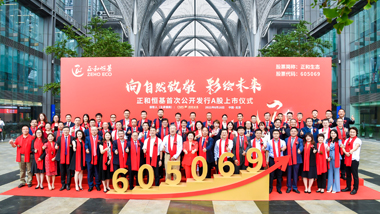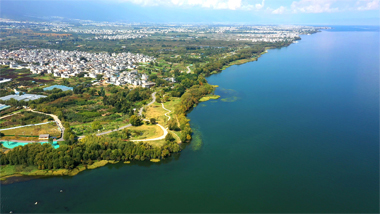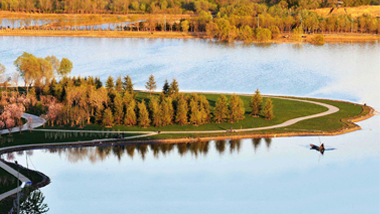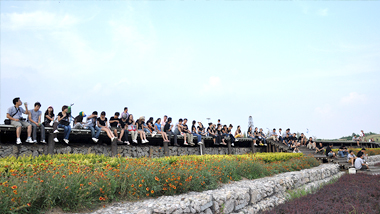Overview
In Bao’an District, Shenzhen and situated where Pailao river, Xinqiao River, Wanfeng River and Tantou River meet, Haoxiang Lake Wetland Park covers an area of 13.1 hectares in which 283 million yuan was invested. Being responsible for design and planning, ZEHO ECO followed Nature-based Solutions and the SymbioCity concept to combine sponge infrastructure and waterfront landscape, added elements of Shajing oyster culture into public space, and introduced green innovative industrial space while improving water quality, managing stormwater and floods as well as restoring ecological environment. The project comprisedf vegetation planting, park construction, lighting, signs, electricity and water supply, footbridge building, park facilities, smart park and surrounding building and road improvement.
Shajing Street, on which the park is located, is at the center of the advanced manufacturing area in Bao’an District, Shenzhen City and the core and breakthrough point of the industrial development in the district. Before the restoration, disorganized companies which generated pollutants and hazardous matters were scattered all over green space, deteriorating the water quality of four rivers running through the area and occupying public space. As a result, the focus point of this design was to improve water quality of rivers, restore ecological environment and meet the needs of residents in neighboring areas.
Highlights
On the theme of “Hub of Green City & New Chapter of Oyster Town”, the project boosted industrial development, advance transportation system, restore aquatic environment and carry forward traditional culture. Specifically, it aimed to create an exemplary smart life on Shajing Street, speed up regional industrial upgrade, link transportation routes, improve non-motorized transportation system, remediate aquatic environment, provide diverse waterfront experiences, showcase local cultural charm and offer Shajing cultural space.
With the central detention basin at the center, the park was divided into four parts, namely wetland, water stage, water garden and water ecological island, providing wetland experience, ecological exhibition, nature education, leisure activities and oyster culture presentation. The four sections are connected by an annular footpath, particularly presenting a panoramic view on the route of Rainbow Bridge (Pailao River)—Café on Sluice Overlook (Tantou River)—Estuary Viewing Platform (Xinqiao River)—Lakeview Corridor (Wanfeng River), thus vitalizing the waterfront area.
Feature One: A Complete Sponge Park System
Based on the condition of the site, we considered sponge infrastructure which intercepts, keeps and purifies water when designing the landscape, forming a complete sponge system which incorporates stormwater management, water quality assurance, biodiversity protection and popularization of science.
(1) Stormwater management
With 32% of green space being sunken, namely wetland garden, rain garden, vegetated swales, etc., rainwater and flood management have been facilitated. The permeable pavement, vegetated swales and other water-intercepting sponge infrastructure can slow down the rain flow to alleviate the scouring. Rainwater flows through vegetated swales, permeable pavement or downspouts to sunken green space, and the overflow goes into Gangtou retention basin or municipal water system through pipe culverts.
The annular footpath was paved with permeable concrete in low-saturated colors, matching the ecological scene as well as reducing rain and flood peak.
(2) Water quality assurance
Rain runoff is collected, funneled and purified by vegetated swales on the edge of the park, flowing to lower grounds and eventually to rain and wetland gardens which are at the end of transferring infrastructure.
When it rains, the wetland garden takes in runoff from the margins of the park and absorbs water from the detention basin when it’s sunny. The purification process of “settling pond—subsurface flow wetland—surface flow wetland—scenery water bodies” intercepts diffuse water pollution and improves the quality of scenery water.
(3) Biodiversity protection
The shallow water follows a tortuous course in the deep-groove rain garden. The planting zone is divided into detention area, buffer area and marginal area based on the amount of water. Factoring in flood and drought tolerance of different plants, we chose emerged plants like Phragmites, Umbrella Papyrus, Powdery Thalia, etc., floating-leaved plants such as Pygmy Water Lily, and submerged plants, e.g., Curly-Leaf Pondweed and Western Waterweed. Through growing diversified aquatic plants, we have created a scenery, reshaped the ecological habitat in the park, and provided an environment where small animals can feed, hide and settle, boosting biodiversity.
(4) Popularization of science
The stepped wetland permeable revetment replaced the original one, connecting wetlands on gentle slopes near the estuary. The purifying structure of “vertical subsurface flow wetland—horizontal subsurface flow wetland—horizontal subsurface flow wetland—surface flow lake” alleviates the scouring and purifies water.
The stepped wetlands function as a habitat for multiple aquatic plants, which can purify water and provide an amusing wetland view for people to experience and learn about nature. A multi-story viewing platform was set up on the higher ground for an exhibition venue of wetland plants, substrates and other water purification means.
Feature Two: A Dynamic and New Public Space Presenting Local Characteristics
From the perspective of utilizing local culture elements, upgrading the site and applying new materials and technologies, the project built a Shajing-tailored public space which can carry forward local culture and traditions, demonstrate features of the site and boost the development of the area.
(1) Utilize local culture elements
The Shajing oyster tops the list of “Four Treasures of Bao’an”, being a symbol of Shajing folk culture. Focusing on “oyster” and the traditional technique of building walls out of oyster shells, we used oyster shells, a porous, low-carbon and environmentally friendly material, for modern building to preserve local culture and create a sense of belonging for citizens in public space.
(2) Upgrade the site
The urban area of the site has been revitalized in terms of its image and function in the brand-new green space. We upgraded water conservancy facilities which needed to be preserved and incorporated them into the landscape with their functions, e.g., serving as a viewing space on the bank converted from an old sluice.
The main building of the deserted Shajing power plant has been turned into a venue of cultural and innovative exhibition. Its surrounding areas can be used flexibly and there is a large meadow and a site for outdoor performance. By doing so, we have created a flexible and intelligent space for citizens and given an impetus to the industrial upgrading.
(3) Apply new materials and technologies
We used organic and renewable materials for the main entrance sign, light materials for the eye-catching Corridor of the Wind and parametric design for the diamond-shaped roof and curtain wall of the Flora Trellis. With the green scenery as the background, everything looks beautiful both ecologically and artistically, showing the charm of the revitalized, smart and innovative city.
Results
By applying sponge city technologies, the project has improved water management and set an exemplary model of restoring aquatic ecology. It has increased the total management capacity to 4245.54 m³, total amount of annual runoff control rate to 84.58% and pollutant diminution rate (of TSS) to 67.66%, largely reducing urban water pollution caused by surface runoff.
Meanwhile, the proportion of bioretention facilities in green space is now 30%, remarkably boosting biodiversity. The wetland garden purifies water and forms different ecological habitats, namely water surface, ecological shallow waters, wetland, etc., based on the diverse combination of plants. This has beautified the surrounding environment and provided small habitats for birds, fish and benthos, preserving biodiversity and creating a healthy and sustainable ecosystem.
While improving the environment of the city, the project has also provided a recreational place for residents and promoted the industrial and economic development in the surrounding areas. Formed by different water bodies, the river network has closely connected the city with daily life and production, coordinating urban development and ecological protection. The high-standard flood discharge channels, ecological corridors, leisure footpaths, cultural routes and industrial chains have created an image for a greener Shajing by drawing its past and future together.






